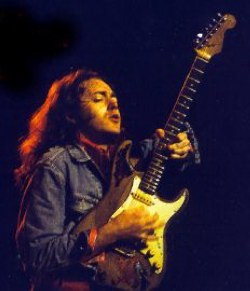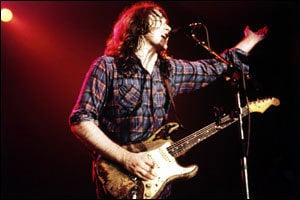Rory Gallagher
Contents |
Introduction
Rory Gallagher (2 March 1948–14 June 1995)
Career
Gallagher's first bands were showbands which played the popular hits of the day. In 1965 he turned Impact into an R'n'B group which played gigs in Ireland and Spain.
He formed Taste in 1966, but the line-up which gained fame was formed in 1967, featuring Gallagher on guitar and vocals, John Wilson on drums and Richard McCracken on bass. The group released the albums, Taste and On the Boards, and made two live recordings, Live at Montreux and Live at the Isle of Wight. The latter appeared long after the band's break-up, which occurred shortly after their appearance at the 1970 Isle of Wight Festival (Headlined by Jimi Hendrix).
After the break-up of Taste, Gallagher toured under his own name, hiring bass player Gerry McAvoy to play on his first eponymous album (a relationship that would last twenty years on the road) and Wilgar Campbell on drums.
The 1970s were Gallagher's most prolific period. He produced ten albums in that decade, including two live albums, Live in Europe and Irish Tour '74, which for many best captured his bands' raw and naturally dynamic qualities.
In 1972 he released the album Deuce, which is essentially three-piece R&B. Also in 1972 he was voted Melody Maker's Top Musician of the Year, dethroning Eric Clapton. His album Live in Europe has been a big selling album not only in Ireland but also internationally.
Gallagher played and recorded what he said was "in me all the time, and not just something I turn on ...".
Though he sold over thirty million albums world wide, it was his marathon live performances that won him greatest acclaim.
His passion and skill for the blues is documented in the 1974 film Irish Tour '74, directed by Tony Palmer.
The line-up including Rod De'Ath on drums and Lou Martin on keyboards stayed together between 1973 and 1978. Other release highlights from that period include Against the Grain, the jazz-tinged Calling Card album (assisted in production by Roger Glover (bassist with Deep Purple) and the hard blues-rocking Photo Finish and Top Priority albums.
A dedicated follower of blues music, Gallagher played with many of the genre's biggest stars, collaborating with Muddy Waters and Jerry Lee Lewis on their respective London Sessions in the mid 70s. Gallagher was also invited to tryout with The Rolling Stones following the resignation of Mick Taylor and with Canned Heat after the departure of "The Eagle". He was David Coverdale's second choice (after Jeff Beck) to replace Ritchie Blackmore in Deep Purple.
In the 1980s he continued recording, albeit at a slower pace, producing Jinx, Defender, and Fresh Evidence. These albums progressed towards a more mature blues style. After Fresh Evidence, he embarked on a successful tour of the United States.
Death
Gallagher's health and his ability to perform were increasingly compromised by excessive use of alcohol, combined with drugs that had been prescribed to alleviate his anxiety about flying.
From the late 1980s, he suffered increasingly poor health, yet he continued touring. By the time of his final performance on 10 January 1995 in the Netherlands, he was visibly unwell. A liver transplant became necessary and was nearly successful, but just before being discharged from the hospital, an MRSA infection developed.
His health quickly worsened and he died in London on 14 June 1995, leaving no wife or children.
Gallagher's final resting place is in St Oliver's Cemetery, on Model Farm Road just outside Ballincollig near Cork City, Ireland. His headstone is a replica of an award he received in 1972 for International Guitarist of The Year.
Gear
Rory's '61 Strat!
Gallagher was always associated with his well-worn sunburst 1961 Stratocaster (Serial Number 64351), which his brother Donal has officially retired. It was reputedly the first in Ireland, ordered by a showband member who changed his mind about the colour. Gallagher bought it for just shy of £100 at Crowley's Music Store on Cork's McCurtain Street.
The guitar was extensively modified by Gallagher. The tuning pegs, for a start, are odd (5 Sperzels and one Gotoh), and all of these have been found to be replacements.
Secondly, it is thought that the nut has been replaced and interchanged a number of times.
Thirdly, the scratchplate was changed during Gallagher's time with Taste. Another change was the pickups of which none are original.
The final modification was that of the wiring. Gallagher disconnected the bottom tone pot and rewired it so he had just a master tone control along with the master volume control. He also installed a 5-way selector switch in place of the vintage 3-way one. The most notable effect that years of touring have had is the almost complete removal of the guitar's original sunburst finish, partly through being left out in the rain in a ditch for days after being stolen and partly due to Rory's blood Type!! He had amazingly acidic Sweat!!
Other quirks include a 'hump' in the scratch plate which moves the neck pickup closer to the neck on the bass side and a replacement of all of the pickups, though this replacement was due to damage rather than a perception of a tonal inadequacy. Reproductions of the guitar have recently been sold by Fender, though with smaller frets and lower action than the original.
Other instruments:
Gallagher owned a number of other instruments, including:
- Coral Sitar Purchased for $20.00 in Florida by Donal Gallagher. Used on the song "Philby" in 1979.
- Danelectro Silvertone This guitar was bought for $15 from a pawnshop. It was often used in Gallagher's live set to play "Cradle Rock" and "A Million Miles Away".
- Fender Esquire This guitar dating to 1959 was heavily modified. It started off as a stock Esquire in cream and ended up as a black Telecaster. At one point in between, Gallagher put a Strat pickup in the middle position and added a 5-way selector.
- Gibson Les Paul Junior.
- Fender Telecaster (1967) This was very similar to the Esquire after the Esquire had undergone all of its modifications. It can be seen in action on Gallagher's Live at Rockpalast DVD in the song "Bullfrog Blues".
- Gretsch Corvette (1963) Bought in a pawn shop in L.A. for $50 by Donal Gallagher. Soon became one of Rory's favourite guitars.
Acoustic Guitars:
His main acoustic guitar was a Martin D-35. In his later years, he used an Electro-Acoustic Takamine (a prototype model given to him by Takamine while he was touring Japan) that was much easier to amplify in a live context.
- Martin Mandolin: This was used most famously in Gallagher's joint effort with Lonnie Donegan, "Goin' To My Hometown".
- National Resonator (1932) Gallagher used this to play blues standards and acoustic sets and often used a heavy steel slide with it.
Other Instruments Gallagher also played the saxophone, showcased on the song "On The Boards" by Taste, and harmonica, which can be heard on the songs "I'm Not Surprised" and "I Could've Had Religion".
Amplifiers and effects:
Gallagher used various makes and models of amplifiers during his career. In general, however, he preferred smaller 'combo' amplifiers to the larger, more powerful 'stacks' that are popular with rock and hard rock guitarists. To make up for the relative lack of power on stage, he would often link several different combo amps together.
When Gallagher was with Taste, he used a single Vox AC30 with a Dallas Rangemaster treble booster plugged into the 'normal' input. Examples of this sound can be heard on the Taste albums, as well as the album Live in Europe. Brian May, of the band Queen, has admitted in interviews that as a young man, he was inspired to use a similar amplifier and treble booster setup after meeting Gallagher and asking him how he got his sound. Gallagher has also been known to have used Ibanez Tube Screamers and various Boss effects.
In the early to mid 1970s, Gallagher began to use Fender amplifiers, most notably a Bassman and a Twin, both of a 50s vintage. An example of this sound can be heard on the Irish Tour '74 album. He also had a Fender Concert amplifier.
In the mid to late 1970s, when Gallagher was moving towards a hard rock sound, he experimented with Ampeg VT40 and VT22 amps. He also began using Marshall combos. During this period and beyond, Gallagher used different combinations of amps on stage to achieve more power and to blend the tonal characteristics of different amps including Orange amplification.
Discography
Studio Albums:
Rory Gallagher - 1971 (BPI: 100,000)
Deuce - 1971 (BPI: 100,000)
Blueprint - 1973 (BPI: 100,000)
Tattoo - 1973 (BPI: 100,000)
Against the Grain - 1975 (BPI: 100,000)
Calling Card - 1976 (BPI: 60,000)
Photo-Finish - 1978 (BPI: 60,000)
Top Priority - 1979 (BPI: 60,000)
Jinx - 1982 (BPI: 60,000)
Defender - 1987 (BPI: 60,000)
Fresh Evidence - 1990 (BPI: 60,000)
The G-Man Bootleg Series Vol.1 - 1992
Let's Go To Work - 2001
Meeting With The G-Man - 2003 (Bootleg-Release)
Live Albums:
Live In Europe - 1972 (BPI: 100,000)
Irish Tour - 1974 (BPI: 100,000; Worldwide sales: +2,000,000)
Stage Struck - 1980 (BPI: 60,000)
BBC Sessions - 1999
Compilations:
The Story So Far - 1974
Sinner... and Saint - 1975 (previously from Rory Gallagher and Deuce)
Take It Easy Baby - 1976
The First And The Best - 1978
A Blue Day For The Blues - 1995
Last of the Independents - 1995
Etched In Blue - 1998 (BPI: 60,000)
Wheels Within Wheels - 2003
Big Guns: The Very Best Of Rory Gallagher - 2005
Live At Montreux - 2006
The Essential - 2008
--Sensible Jones 17:44, 17 February 2009 (CET)







